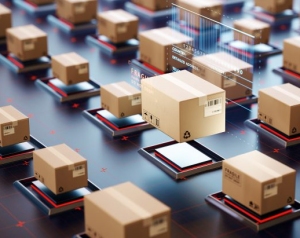
Anti-counterfeit Packaging Combats Spread of Fake Goods with Advanced Printing and Security FeaturesBy Sam Upton  A low-cost RFID/NFC inlay embedded into food packaging can be used not only for coupons and recipes, it can also be used to give consumers information about food storage, cooking and safety.
A low-cost RFID/NFC inlay embedded into food packaging can be used not only for coupons and recipes, it can also be used to give consumers information about food storage, cooking and safety.
April 2, 2019 - With the global market for anti-counterfeit packaging growing to $9.4bn by 2023, ensuring your customers are buying the real thing is big business. So how can packaging fight the war against fake goods? The online retail world may be booming across the globe, but it currently faces a problem that's causing it to lose billions of dollars every year. Whether it's clothes, bags, watches, jewelry, perfume or food, the internet is rife with sites selling counterfeit goods. Last year, over 31,000 UK sites were closed down by the City of London police's intellectual property crime unit in just one month. As the quality of counterfeit goods increases, so does the difficulty in telling them apart, so one of the main ways genuine brands are combating fake goods is through their packaging. With new printing technology and enhanced security features, packaging is quickly becoming the best way to ensure that consumers are buying the genuine item, rather than poorly made and, in the case of food, toys and electronic goods, unsafe counterfeits. According to recent research by Markets and Markets, the global market for anti-counterfeit packaging will grow from $5.3bn in 2018 to $9.4bn by 2023. This increase is driven by factors such as the growing number of counterfeit products, increasing brand awareness amongst buyers, the expansion of the e-commerce industry, concerns regarding brand image and developments in printing technologies. Effective effectsMany brands, particularly in the food and drinks market, are taking advantage of the range of print effects to not only provide brand protection in the global market, but give their products real stand-out value on the shelf. For example, Fresnels have developed a carton that features foil-printed embossing, as well as covert security features that can only be detected via a hand-held device. Not only do such elements provide a quick way to identify the genuine article, but they give designers an extra dimension in creating eye-catching packaging. “We are seeing mechanically produced Fresnel lens effects as fascinating additions to packaging,” said Glenn Wood, Chief Operating Officer of Fresnels. “However, the real prize is digitally produced images offering graphic designers much greater scope for creativity.” Chips with everythingOne of the major developments in packaging security is RFID, which is predicted to be the fastest-growing technology in the area. Radio Frequency Identification, to give it its full name, is the use of an electronic chip – or tag – embedded within packaging, which holds information that can be read by an electronic device. That information could be anything from which country the product was made in to the name of the individual who made it. As well as a guarantee of authenticity, RFID gives a business the ability to track and trace every individual product, as well as provide another marketing platform to reach out to customers. With RFID technology starting to incorporate Near-Field Communication (NFC), as well as the well-established UHF frequency, customers can now use the packaging to connect to the brand's website just by tapping their smartphone on the label. As well as general information about the product, you could also access information about the individual product in your hand, such as its expiry date. It could even help combat food and packaging waste. “One major cause of food waste in the developed world is consumer confusion about the labelling of food,” says Gillian Ewers, Vice President of Marketing at electronics company PragmatIC. “A low-cost RFID/NFC inlay embedded into food packaging can be used not only for coupons and recipes, it can also be used to give consumers information about food storage, cooking and safety. Also, as each item can be uniquely identified, the consumer can be given location-specific information about recycling both food and packaging waste, improving the chances of recovery rather than landfill.” Editor's Note: Sam Upton is Founder and Editorial Director of Soul Content. This article was published on Two Sides website: www.twosides.info Two Sides was created in 2008 with members from the graphic communications supply chain, creating a forum for the industry to work together and share experiences; improving standards and practices; maximising customer confidence in our products. SOURCE: Two Sides |